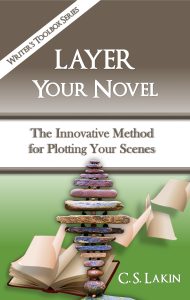How Layering Your Novel Brings Order out of Chaos
I’ve been writing novels and teaching novel structure for many years, but I’ve shied away from going into detailing what scenes should come where in a novel.
Why? Because there are countless books and blog posts that cover story structure, and a lot of great ones too, so, I figured, why should I add my two cents to the mix?
But the longer I thought about it, the more I realized I have some unique approaches and twists to the age-old question: “How do I write a great novel?”
By layering scenes—that’s how.
I searched through titles and descriptions of dozens of writing craft books specific to structuring novels, and it hit me. None of these books talk about layering.
And I’ll tell you why that confused me: layering is the most logical and intuitive way to structure a great story.
That’s how I write all my novels. And the process isn’t hard.
Creating Order out of Chaos
Novels are made up of scenes. Lots of scenes. If you’re a pantser, you wing it and write whatever scenes come into your head. If you’re a plotter, you sit down and make a list of as many scenes as you can think of, and then you try to put them in order as best you can, maybe create an outline, and then hope it works.
If you’ve written a lot of novels, you probably have a good sense where scenes need to fall in your story. You may know that you need some initial disturbance (also called “the inciting incident”) to kick off your story somewhere near the beginning of your novel.
And you might also know that at some point your protagonist should be pursuing a goal (but, believe me, a lot of writers don’t even understand this is at the crux of plot and premise) that builds to a climax somewhere near the end. And then you figure you need to wrap things up and end the darn thing.
How Many Scenes Do You Really Need to Start Writing?
Elizabeth George, in her terrific craft book Write Away, talks about how a writer should have about ten to fifteen scenes figured out before starting in on writing. That’s going to vary from writer to writer. Some writers, like me, want to have about thirty to fifty scenes roughly figured out (and put on index cards) before diving into writing.
I always allow for spontaneous character takeover. Meaning, my characters, as is the way with most well-developed characters, often go riding off in some direction I hadn’t planned. And most of the time they know what they’re doing and I go along for the ride.
It’s important to be flexible, to allow for new scene ideas to pop up. But I’m a stickler for strong structure.
So whether you can pull a great novel together with laying out only a dozen key scenes before you start writing, or you need to work up more scenes, know that it’s going to be a tremendous help if you do this “laying out” work before you start writing.
Stop “Pantsing” Already!
You pantsers out there: I don’t know how you are still following my blog (she says, laughing). You know how opposed I am to winging it when it comes to writing a novel.
Seriously, you writers out there who just “can’t plot.” You can. You just don’t want to.
And maybe you love to suffer through wasted months or years of your life throwing out draft after draft and agonizing all the way through (what is supposed to be a fun process!) your novel writing wondering if your story is any good.
So I’m inviting you all—pantsers too—to try this on. This layering concept I’m presenting. You will find it so much more fulfilling to have efficient and productive writing time so you can actually have a life. Go on trips with your family. Watch the NBA finals. Take hikes with your dog. Smell the roses. You get to do all that with all the time you save when you plot instead of write by the seat of your pants.
Yes, It Is All about Structure
Maybe you’ve heard of plot points and turning points and pinch points, and you’ve resisted learning about them. I did. For years. I didn’t want to write formulaic novels; I wanted to be original, different, unique.
I totally missed the boat on that one. I didn’t get that I must follow expected novel structure, very specifically, to craft a terrific novel. I didn’t get that there are specific types of scenes that must appear at specific places (percentage-wise) in my novel—or else!
In other words, I thought I could just intuitively write my novels, and all the scenes would magically fall into the right slots and I could call it good.
Not.
And this applies to all genres, not just “genre” or popular fiction.
 Here’s the thing: if you want to sell well, you’ll have a better chance if you stick with time-tested structure. And that means understanding what types of scenes you need to frame your novel and where to put them. This is what my upcoming book is all about. Watch for Layer Your Novel end of summer 2017.
Here’s the thing: if you want to sell well, you’ll have a better chance if you stick with time-tested structure. And that means understanding what types of scenes you need to frame your novel and where to put them. This is what my upcoming book is all about. Watch for Layer Your Novel end of summer 2017.
Ever wonder why some authors who sell millions of copies of their books struggle painfully with writing novel after novel, figuratively tearing their hair out and agonizing over each one? I know authors like this. They have a big love-hate relationship with writing. The “hate” part could be avoided though—this I truly believe. Because the “hate” part is due to their resistance to learn and master novel structure. In particular I’m talking about what scenes are needed where in a novel.
I don’t know any writers (though I’m hoping they’re out there) who, before starting to write their novel, sit down and work out their key scenes—well, other than my clients, who’ve taken my advice! I’m talking about those milestones in your plot—which I refer to as the ten key scenes. Writers often lay out a list of a dozen or so scenes they want in their story, but they aren’t thinking about specific key scenes that must go in specific places.
How about you? How have you been approaching your scene organization? Do you just start with the first few scenes and wing it as you go along? Do you lay out your main scenes and then start writing? Or do you come up with every scene needed and create an outline?
The big question is: How do you know where to put each scene? Do you guess, go on intuition, by what feels right? What do you think about working with a more specific framework?
I want to hear from you, so share in the comments!












Over the years I’ve learned to develop very detailed outlines. Yes, this includes key scenes following the conventional plot outline and all the other information I’ve learned about plotting.
Thank you for this article. I found it interesting.
I don’t know how someone can avoid not layering a novel. I might know where something a chapter or scene is supposed to go, but almost always something weird ends up happening. For example, a character says something that might impact something later in the story.
Or you’re got about half a dozen different things all leading up to one thing.
As I see it, you just can’t get away from it.
You’d be surprised how many writers don’t plot, don’t layer, don’t really organize any parts of their novel. The result is usually a disaster.
I’ve always been a dedicated plotter. But in doing Camp NaNoWriMo this July, I started outlining the book a few months before I started, and I didn’t allow myself to actually write any scenes until July 1.
That forced me to spend more time with the outline, putting in new ideas, etc, before I did any writing.
As a result, the 50K words flowed out in 23 days, and it was the easiest writing process I’d had for any of my books.
Nice! I bet now you’ll be outlining and plotting before you start any new book!
I’m an outliner, too. Before I dive into an outline, however, I spend some time crafting backstory, setting, and “state of affairs” for my epic fantasy universe. For my major and “major minor” characters, I write first-person backstory from a time period in the book where they are facing their most painful moment. I find it’s hard to write a story, if you don’t have a crystal clear idea of your characters’ motivation and pain points.
Like you, I usually have most if not all of what I expect (notice “expect”; things always change) to be the key scenes for my entire story before I start outlining. I bullet these out, making sure I jot down key descriptions, backstory tid bits, choice dialog. Then I bullet out all the scenes I think I need to get from “A” to “B” to etc. When the outline is done, then I hold my nose and dive in laying down narrative. My outline may change as the characters take over, but at least I have some sort of foundational roadmap to follow.
Thanks, Cindy. I also write out pages for each character. I’ll pull archetypal qualities into some of them (which is helpful!) and think of ways to create those characteristics that will clash with the other characters in the story.
I’m a firm believer that you need to know where you are going in a novel before beginning to write. This way you can be sure all scenes lead up to the outcome. Thanks for sharing this with your followers.
Terrific post. Over the years I’ve slowly evolved from pantser to plotter. I now have a good idea of my protagonist’s goal, some obstacles, and maybe a sketchy notion of the turning points and a possible climax. Elizabeth George is one of my favourite authors too, so I’ve taken her advice and outlined about 8-10 scenes before beginning.
But your notion of specific key scenes that go in specific places is like finding the light switch in an unfamiliar house. Ta da! Now I can see where I’m going. Can’t wait to sit down and try it.
Well, I have a lot of posts on this, so in lieu of getting the book, which should be out in a couple of months, it might help you to read through all the posts on the ten key scenes and where they go. Those are the framework to every strong story. Hope they help!
When I started writing, back in the ’70’s, it was mostly for therapy. I took several courses, when feedback suggested I should try to publish. But it dealt mostly with “beginning, middle, end.” While I read enough to have an intuitive grasp of structure, I was, still, for the most part “pantsing” it. Lack of support in my personal life, indeed turning to outright hostile opposition to my hobby, and I got to where I was hiding my output again, like I did in kindergarten. (Pictures in crayon count, don’t they?) — Years later, when I had changed everything around and lived a new lifestyle with a new set of “supportive” elements surrounding me, I boldly made a few submissions, and — voila! — a sale! — My most sincere (and, until then, closest) supporter acted like I’d shot his dog! He said, “It puts distance between us.” –He was right. But out came the kindergarten shoe box again.
I couldn’t not write. But I couldn’t submit either. So, the box got bigger and fuller.
Fast forward thirty-five years. I survived a near-fatal but unknown episode after a prolonged, unexplained illness. Interest in the epic tale I’d worked on for ten years or so waned with my health and will to live. The ambulance ride to the hospital was a little over two years ago, and since it was demonstrated that the illness was not “all in my head,” — the cause was discovered, treated, and recovery began, however slowly. During the dark time between discharge from the hospital and finding the correct diagnosis, I got a call, asking about my old manuscripts. It seems I have produced at least one aspiring writer, who wishes to study what I’ve done, for ideas she might pursue in her “leisure” time. (–Is there REALLY such a thing? –If so, where? — When?) With help, I began opening the shoe boxes.
And, the strangest thing happened: I started to get INTERESTED in it again! But, now, I have computers (yes, more than one,) internet, accumulated wisdom and a very small realm of influence that will fail me only once.
I found Live Write Thrive (no idea when or how — probably Amazon which took the place of Waldenbooks), Jennifer Blanchard, the new era of books teaching CRAFT, STRUCTURE, and PLOT! — WOW! My income is still limited, but I own many of those, to occupy the shelf with those from years ago.
It has been a difficult but productive two years. “Pantsing” has lost its luster. I learn just as much about myself and a lot more about my characters, and I’ll not only never go back, but I’ll teach my descendants the REAL way to write a knock-out novel!
Thanks, Suzanne!
Thanks for sharing that, Myrna! Isn’t it great that we get so much free, helpful content online via blogs!
Yep. For me, understanding my structure is critical. In my opinion, Susanne is one of the three main story structure gurus, and I follow her like a sergeant follows a captain. Lead on!
I’m a former pantser. Once I started writing suspense, however, I had to find a better way. I love outlining/plotting now. I currently use a self-made template that’s a bastardized version of Hero’s Journey and the four act structure. It works to get me started, but it’s not the best. I’ve been following your 10-20-30 posts and LOVE what you’ve shared. I absolutely can’t wait for your new book on layers to be available! I have a new story idea that I’m eager to try it on. (If it’s not out before that idea ripens, I look forward to using it on another.) Thanks for all you share here!
Thanks, Kathy. If you’d like to be a beta reader, I’ll probably have the rough draft in a few weeks. I have three layering methods I’ve put together: action-reaction, subplot, and romance. And I feel one of those three can work for any novel. And of course I’ve made a lot of charts! Be sure to download the ten key scene chart from my blog and start with that.
Are you kidding?! I’d love to beta read! Just say when. Seriously, I can’t wait to see this in book form. And YES to charts. She who dies with the most charts, wins. Right?
lol!
Such a great post layered with so much information! Thanks, Victoria.Wonderful post. It lends such insight to the craft and architecture of writing.
With the one novel that I’ve finished (so far), I planned four key scenes: opening, climax, ending, and the beginning of Act 2. Apart from those, I pantsed it — just trying to write the most witty and exciting thing I could think of. The result didn’t make me happy. I want to be able to write the kind of book that feels (to the reader) like a perfect Rubik’s cube. Instead, what I produced felt episodic.
I learned:
a) I need to plan more scenes.
b) I need to learn more criteria for judging whether a particular scene is the *best* scene for the place it occupies. (E.g., out of all the many ways I could start Act 2 — all of which contain the necessary plot/character information — how do I know I’m picking the most engaing and delightful one?)
I can hardly wait to get *Layer Your Novel*! 🙂
I already have a number of posts that show ways to layer the first twenty scenes. Check those out and see if they help!
I worked my way through L.Y.N real slow first time ’round, reaching and stretching to understand and apply the concepts to my project. Now,over a year later, I’m speed-reading my way through it.
Just wanted to tell you that your including the sample from “the Fault in Our Stars” along with your highlighting aspects being set-up in that opening scene that play into the plot, is both incredibly helpful as well as SUCH AN INSPIRATIONAL EXAMPLE of how do to it right.
It’s got my brain excited! THANK YOU, nj
You’re welcome! I hope you check out my new online course launching tomorrow: Emotional Mastery for Fiction Writers. It has more than 3 dozen passages as examples of masterful showing of emotion. And the 10 Key Scenes course will give you way more than the book. Check them out at cslakin.teachable.com.